An official website of the United States government
 United States Department of Labor
United States Department of Labor
Lay pipe for storm or sanitation sewers, drains, and water mains. Perform any combination of the following tasks: grade trenches or culverts, position pipe, or seal joints. Excludes “Welders, Cutters, Solderers, and Brazers” (51-4121).
Employment estimate and mean wage estimates for Pipelayers:
| Employment (1) | Employment RSE (3) |
Mean hourly wage |
Mean annual wage (2) |
Wage RSE (3) |
|---|---|---|---|---|
| 33,330 | 3.1 % | $ 23.32 | $ 48,510 | 1.6 % |
Percentile wage estimates for Pipelayers:
| Percentile | 10% | 25% | 50% (Median) |
75% | 90% |
|---|---|---|---|---|---|
| Hourly Wage | $ 14.42 | $ 17.74 | $ 22.11 | $ 28.48 | $ 36.25 |
| Annual Wage (2) | $ 30,000 | $ 36,910 | $ 45,980 | $ 59,240 | $ 75,410 |
Industries with the highest published employment and wages for Pipelayers are provided. For a list of all industries with employment in Pipelayers, see the Create Customized Tables function.
Industries with the highest levels of employment in Pipelayers:
| Industry | Employment (1) | Percent of industry employment | Hourly mean wage | Annual mean wage (2) |
|---|---|---|---|---|
| Utility System Construction | 12,000 | 2.22 | $ 22.65 | $ 47,110 |
| Local Government, excluding schools and hospitals (OEWS Designation) | 7,270 | 0.14 | $ 22.42 | $ 46,630 |
| Other Specialty Trade Contractors | 4,090 | 0.57 | $ 22.37 | $ 46,520 |
| Building Equipment Contractors | 3,390 | 0.15 | $ 27.51 | $ 57,210 |
| Highway, Street, and Bridge Construction | 2,220 | 0.62 | $ 23.19 | $ 48,220 |
Industries with the highest concentration of employment in Pipelayers:
| Industry | Employment (1) | Percent of industry employment | Hourly mean wage | Annual mean wage (2) |
|---|---|---|---|---|
| Utility System Construction | 12,000 | 2.22 | $ 22.65 | $ 47,110 |
| Other Pipeline Transportation | 80 | 0.93 | $ 36.44 | $ 75,790 |
| Land Subdivision | 280 | 0.83 | $ 19.96 | $ 41,510 |
| Highway, Street, and Bridge Construction | 2,220 | 0.62 | $ 23.19 | $ 48,220 |
| Water, Sewage and Other Systems | 320 | 0.61 | $ 22.04 | $ 45,850 |
Top paying industries for Pipelayers:
| Industry | Employment (1) | Percent of industry employment | Hourly mean wage | Annual mean wage (2) |
|---|---|---|---|---|
| Other Pipeline Transportation | 80 | 0.93 | $ 36.44 | $ 75,790 |
| Ship and Boat Building | (8) | (8) | $ 28.94 | $ 60,200 |
| Foundation, Structure, and Building Exterior Contractors | 260 | 0.03 | $ 28.20 | $ 58,650 |
| Building Equipment Contractors | 3,390 | 0.15 | $ 27.51 | $ 57,210 |
| Nonresidential Building Construction | 1,290 | 0.17 | $ 26.87 | $ 55,890 |
States and areas with the highest published employment, location quotients, and wages for Pipelayers are provided. For a list of all areas with employment in Pipelayers, see the Create Customized Tables function.
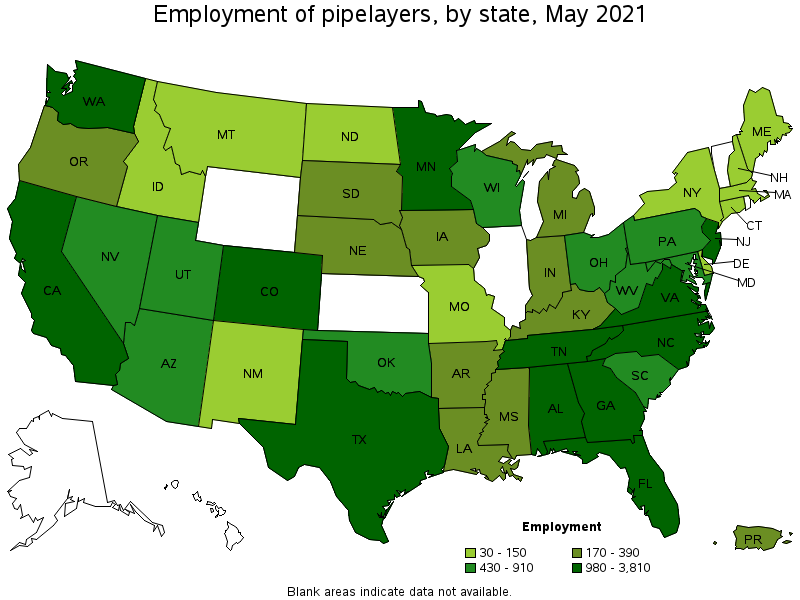
States with the highest employment level in Pipelayers:
| State | Employment (1) | Employment per thousand jobs | Location quotient (9) | Hourly mean wage | Annual mean wage (2) |
|---|---|---|---|---|---|
| Texas | 3,810 | 0.31 | 1.32 | $ 19.02 | $ 39,560 |
| Florida | 3,570 | 0.41 | 1.75 | $ 19.67 | $ 40,910 |
| North Carolina | 3,070 | 0.69 | 2.93 | $ 19.06 | $ 39,650 |
| California | 2,360 | 0.14 | 0.60 | $ 27.77 | $ 57,770 |
| Georgia | 1,420 | 0.32 | 1.37 | $ 17.84 | $ 37,100 |
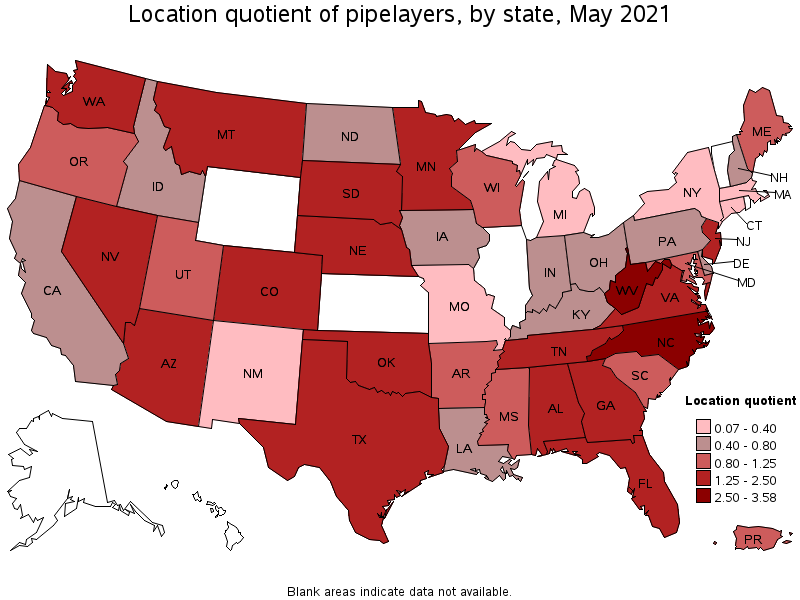
States with the highest concentration of jobs and location quotients in Pipelayers:
| State | Employment (1) | Employment per thousand jobs | Location quotient (9) | Hourly mean wage | Annual mean wage (2) |
|---|---|---|---|---|---|
| West Virginia | 560 | 0.85 | 3.58 | $ 18.71 | $ 38,920 |
| North Carolina | 3,070 | 0.69 | 2.93 | $ 19.06 | $ 39,650 |
| Alabama | 1,070 | 0.56 | 2.35 | $ 19.23 | $ 39,990 |
| Florida | 3,570 | 0.41 | 1.75 | $ 19.67 | $ 40,910 |
| Colorado | 1,090 | 0.41 | 1.75 | $ 24.65 | $ 51,270 |
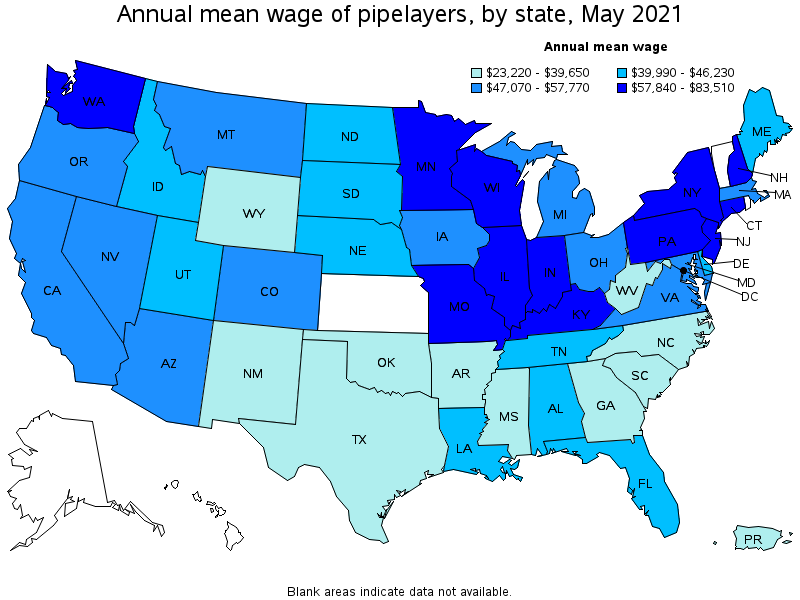
Top paying states for Pipelayers:
| State | Employment (1) | Employment per thousand jobs | Location quotient (9) | Hourly mean wage | Annual mean wage (2) |
|---|---|---|---|---|---|
| New Jersey | 1,180 | 0.31 | 1.30 | $ 40.15 | $ 83,510 |
| Minnesota | 980 | 0.36 | 1.51 | $ 34.65 | $ 72,080 |
| Wisconsin | 710 | 0.26 | 1.09 | $ 31.91 | $ 66,370 |
| Washington | 1,130 | 0.35 | 1.49 | $ 31.26 | $ 65,010 |
| Illinois | (8) | (8) | (8) | $ 29.56 | $ 61,490 |
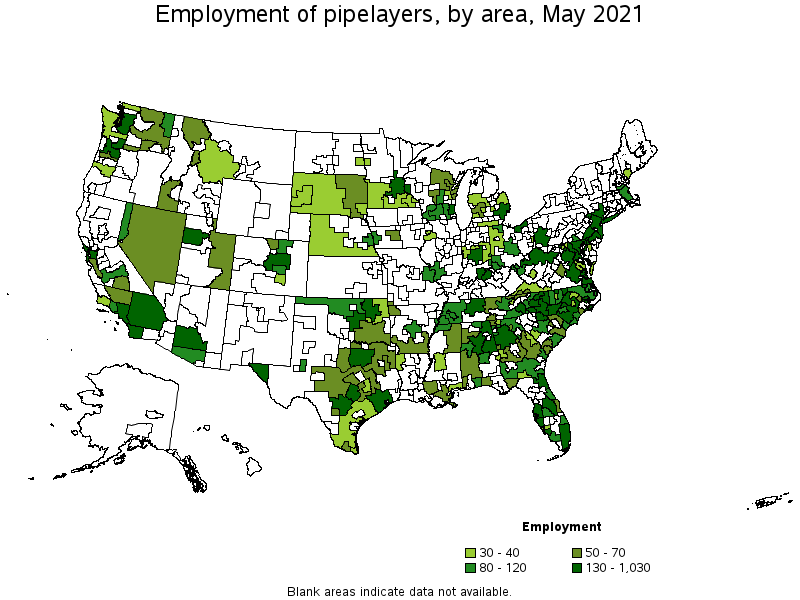
Metropolitan areas with the highest employment level in Pipelayers:
| Metropolitan area | Employment (1) | Employment per thousand jobs | Location quotient (9) | Hourly mean wage | Annual mean wage (2) |
|---|---|---|---|---|---|
| Houston-The Woodlands-Sugar Land, TX | 1,030 | 0.36 | 1.50 | $ 19.73 | $ 41,030 |
| New York-Newark-Jersey City, NY-NJ-PA | 970 | 0.11 | 0.47 | $ 41.49 | $ 86,310 |
| Charlotte-Concord-Gastonia, NC-SC | 900 | 0.75 | 3.15 | $ 20.12 | $ 41,850 |
| Dallas-Fort Worth-Arlington, TX | 900 | 0.25 | 1.05 | $ 19.88 | $ 41,340 |
| Denver-Aurora-Lakewood, CO | 720 | 0.49 | 2.07 | $ 25.79 | $ 53,640 |
| Phoenix-Mesa-Scottsdale, AZ | 710 | 0.34 | 1.43 | $ 23.99 | $ 49,890 |
| Miami-Fort Lauderdale-West Palm Beach, FL | 700 | 0.28 | 1.20 | $ 20.33 | $ 42,280 |
| Seattle-Tacoma-Bellevue, WA | 690 | 0.36 | 1.52 | $ 33.62 | $ 69,930 |
| Minneapolis-St. Paul-Bloomington, MN-WI | 690 | 0.38 | 1.59 | $ 36.30 | $ 75,510 |
| Atlanta-Sandy Springs-Roswell, GA | 660 | 0.26 | 1.08 | $ 19.36 | $ 40,260 |
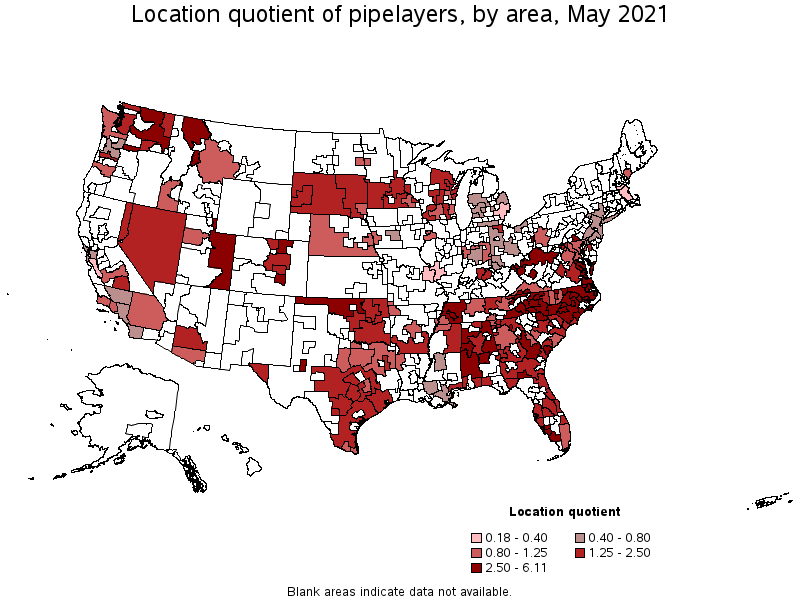
Metropolitan areas with the highest concentration of jobs and location quotients in Pipelayers:
| Metropolitan area | Employment (1) | Employment per thousand jobs | Location quotient (9) | Hourly mean wage | Annual mean wage (2) |
|---|---|---|---|---|---|
| Jackson, TN | 90 | 1.29 | 5.47 | $ 23.79 | $ 49,480 |
| Jacksonville, NC | 50 | 1.12 | 4.74 | $ 16.63 | $ 34,580 |
| Tuscaloosa, AL | 110 | 1.12 | 4.74 | $ 18.81 | $ 39,130 |
| Fayetteville, NC | 120 | 0.99 | 4.19 | $ 19.78 | $ 41,150 |
| Hickory-Lenoir-Morganton, NC | 140 | 0.94 | 3.99 | $ 16.77 | $ 34,890 |
| Asheville, NC | 170 | 0.93 | 3.92 | $ 18.37 | $ 38,200 |
| Midland, TX | 90 | 0.92 | 3.88 | $ 22.33 | $ 46,440 |
| Greeley, CO | 90 | 0.92 | 3.88 | $ 22.74 | $ 47,300 |
| Weirton-Steubenville, WV-OH | 30 | 0.90 | 3.80 | $ 17.71 | $ 36,840 |
| Beckley, WV | 30 | 0.85 | 3.59 | $ 17.73 | $ 36,880 |
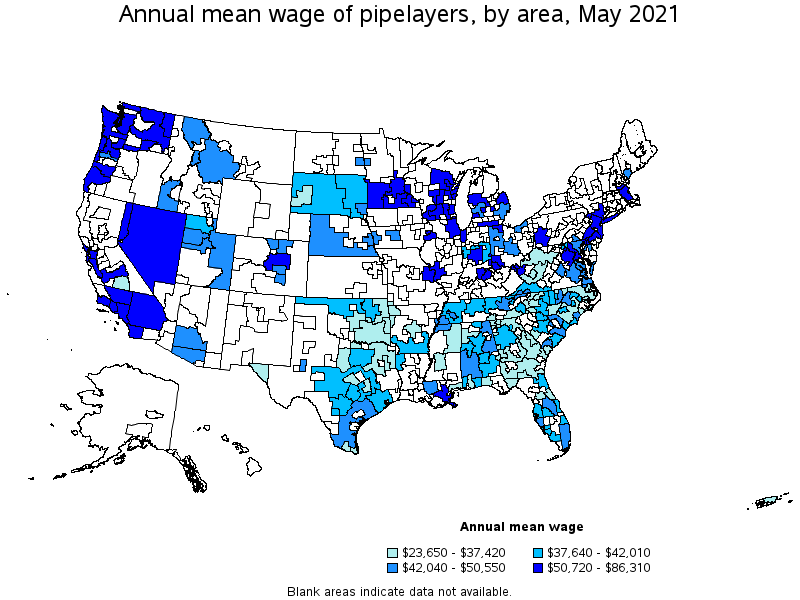
Top paying metropolitan areas for Pipelayers:
| Metropolitan area | Employment (1) | Employment per thousand jobs | Location quotient (9) | Hourly mean wage | Annual mean wage (2) |
|---|---|---|---|---|---|
| New York-Newark-Jersey City, NY-NJ-PA | 970 | 0.11 | 0.47 | $ 41.49 | $ 86,310 |
| Minneapolis-St. Paul-Bloomington, MN-WI | 690 | 0.38 | 1.59 | $ 36.30 | $ 75,510 |
| Madison, WI | 80 | 0.21 | 0.90 | $ 34.04 | $ 70,810 |
| Seattle-Tacoma-Bellevue, WA | 690 | 0.36 | 1.52 | $ 33.62 | $ 69,930 |
| Chicago-Naperville-Elgin, IL-IN-WI | (8) | (8) | (8) | $ 33.58 | $ 69,850 |
| San Jose-Sunnyvale-Santa Clara, CA | 60 | 0.06 | 0.24 | $ 33.34 | $ 69,350 |
| Milwaukee-Waukesha-West Allis, WI | 160 | 0.20 | 0.85 | $ 32.77 | $ 68,160 |
| Bremerton-Silverdale, WA | 50 | 0.57 | 2.40 | $ 32.23 | $ 67,030 |
| Green Bay, WI | 60 | 0.34 | 1.44 | $ 32.12 | $ 66,820 |
| Philadelphia-Camden-Wilmington, PA-NJ-DE-MD | 320 | 0.12 | 0.51 | $ 31.96 | $ 66,490 |
Nonmetropolitan areas with the highest employment in Pipelayers:
| Nonmetropolitan area | Employment (1) | Employment per thousand jobs | Location quotient (9) | Hourly mean wage | Annual mean wage (2) |
|---|---|---|---|---|---|
| Southeast Coastal North Carolina nonmetropolitan area | 210 | 0.88 | 3.71 | $ 17.74 | $ 36,910 |
| Northern West Virginia nonmetropolitan area | 190 | 1.44 | 6.11 | $ 17.52 | $ 36,440 |
| Piedmont North Carolina nonmetropolitan area | 180 | 0.75 | 3.15 | $ 17.11 | $ 35,580 |
| Northeast Alabama nonmetropolitan area | 150 | 1.06 | 4.49 | $ 20.42 | $ 42,480 |
| South Georgia nonmetropolitan area | 100 | 0.57 | 2.41 | $ 15.15 | $ 31,510 |
Nonmetropolitan areas with the highest concentration of jobs and location quotients in Pipelayers:
| Nonmetropolitan area | Employment (1) | Employment per thousand jobs | Location quotient (9) | Hourly mean wage | Annual mean wage (2) |
|---|---|---|---|---|---|
| Northern West Virginia nonmetropolitan area | 190 | 1.44 | 6.11 | $ 17.52 | $ 36,440 |
| Northwest Alabama nonmetropolitan area | 70 | 1.10 | 4.63 | $ 17.51 | $ 36,420 |
| Northeast Alabama nonmetropolitan area | 150 | 1.06 | 4.49 | $ 20.42 | $ 42,480 |
| Northeast Coastal North Carolina nonmetropolitan area | 90 | 0.98 | 4.14 | $ 16.78 | $ 34,890 |
| Northwest Oklahoma nonmetropolitan area | 80 | 0.89 | 3.75 | $ 19.52 | $ 40,600 |
Top paying nonmetropolitan areas for Pipelayers:
| Nonmetropolitan area | Employment (1) | Employment per thousand jobs | Location quotient (9) | Hourly mean wage | Annual mean wage (2) |
|---|---|---|---|---|---|
| South Central Wisconsin nonmetropolitan area | 80 | 0.40 | 1.71 | $ 33.26 | $ 69,180 |
| Southwest Minnesota nonmetropolitan area | 40 | 0.31 | 1.30 | $ 31.29 | $ 65,070 |
| Northeastern Wisconsin nonmetropolitan area | 70 | 0.36 | 1.52 | $ 30.77 | $ 64,010 |
| Southeast Minnesota nonmetropolitan area | 40 | 0.30 | 1.27 | $ 29.13 | $ 60,600 |
| Balance of Lower Peninsula of Michigan nonmetropolitan area | 40 | 0.14 | 0.61 | $ 27.59 | $ 57,390 |
These estimates are calculated with data collected from employers in all industry sectors, all metropolitan and nonmetropolitan areas, and all states and the District of Columbia. The top employment and wage figures are provided above. The complete list is available in the downloadable XLS files.
The percentile wage estimate is the value of a wage below which a certain percent of workers fall. The median wage is the 50th percentile wage estimate—50 percent of workers earn less than the median and 50 percent of workers earn more than the median. More about percentile wages.
(1) Estimates for detailed occupations do not sum to the totals because the totals include occupations not shown separately. Estimates do not include self-employed workers.
(2) Annual wages have been calculated by multiplying the hourly mean wage by a "year-round, full-time" hours figure of 2,080 hours; for those occupations where there is not an hourly wage published, the annual wage has been directly calculated from the reported survey data.
(3) The relative standard error (RSE) is a measure of the reliability of a survey statistic. The smaller the relative standard error, the more precise the estimate.
(8) Estimate not released.
(9) The location quotient is the ratio of the area concentration of occupational employment to the national average concentration. A location quotient greater than one indicates the occupation has a higher share of employment than average, and a location quotient less than one indicates the occupation is less prevalent in the area than average.
Other OEWS estimates and related information:
May 2021 National Occupational Employment and Wage Estimates
May 2021 State Occupational Employment and Wage Estimates
May 2021 Metropolitan and Nonmetropolitan Area Occupational Employment and Wage Estimates
May 2021 National Industry-Specific Occupational Employment and Wage Estimates
Last Modified Date: March 31, 2022